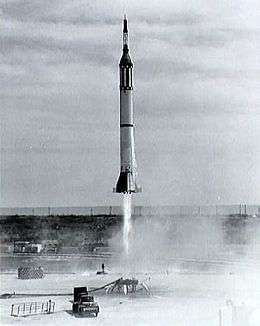Mercury-Redstone BD
 Mercury Redstone BD launch | |||||
| Mission type | Test flight | ||||
|---|---|---|---|---|---|
| Operator | NASA | ||||
| Mission duration | 8 minutes, 23 seconds | ||||
| Distance travelled | 494 kilometres (307 mi) | ||||
| Apogee | 182.7 kilometres (113.5 mi) | ||||
| Spacecraft properties | |||||
| Spacecraft type | Mercury boilerplate | ||||
| Manufacturer | McDonnell Aircraft | ||||
| Launch mass | 1,141 kilograms (2,515 lb) | ||||
| Start of mission | |||||
| Launch date | March 24, 1961, 17:30 UTC | ||||
| Rocket | Redstone MRLV MR-5 | ||||
| Launch site | Cape Canaveral LC-5 | ||||
| End of mission | |||||
| Landing date | March 24, 1961, 17:08:23 UTC | ||||

| |||||
Mercury-Redstone BD was an unmanned booster development flight in the U.S. Mercury program. It was launched on March 24, 1961 from Launch Complex 5 at Cape Canaveral, Florida. The mission used a boilerplate Mercury spacecraft and Redstone MRLV-5.[1]
After the problems that developed during the MR-2 mission carrying the chimpanzee Ham, it was apparent that the Redstone needed further development before it could be trusted to carry a human passenger.
Dr. Wernher von Braun added Mercury-Redstone BD (Booster Development) to the launch schedule between the MR-2 and MR-3 missions.
The cause of previous Redstone rocket over-accelerations was a servo valve that did not properly regulate the flow of hydrogen peroxide to the steam generator. This in turn overpowered the fuel pumps. The thrust regulator and velocity integrator were modified on the MR-BD and later Mercury-Redstone rockets to prevent them from exceeding the speed limit again.
Another problem encountered in previous Mercury-Redstone flights were harmonic vibrations induced by aerodynamic stress in the topmost section of the elongated Redstone. To fix this problem, four stiffeners were added to the ballast section and 210 pounds (95 kg) of insulation was applied to the inner skin of the upper part of the Mercury Redstone instrument compartment.
The mission used a boilerplate Mercury spacecraft, with inert escape rocket. The spacecraft also did not have a retro package or posigrade rockets.
The MR-BD mission lasted eight minutes and 23 seconds. It reached an apogee of 113.5 miles (183 km) and a range of 307 miles (494 km). The peak velocity was 5,123 mph (8,245 km/h). The spacecraft experienced a peak load of 11 g (108 m/s²). There was no intention to separate the Redstone rocket and boilerplate Mercury spacecraft and they impacted together 307 miles (494 km) downrange, five miles (8 km) short of the plan. They sank to the bottom of the Atlantic Ocean, exploding a sofar bomb en route.
MR-BD was highly successful and led the way to the flight of Alan Shepard aboard MR-3.
Trivia
In the USSR, the mission was erroneously recognized as failure:
The Commander reported that the Americans are planning to fly into space on April 28. I told him that they will not launch a man before us. On March 24 they had a big failure: capsule "Mercury" failed to separate from the carrier and sank in the ocean.
References
- ↑ Loyd S. Swenson Jr., James M. Grimwood, Charles C. Alexander (1966). "This New Ocean: A History of Project Mercury - NASA SP-4201". NASA Special Publication-4201 in the NASA History Series. p. 7. Retrieved 26 June 2013.
|chapter=ignored (help)
![]() This article incorporates public domain material from websites or documents of the National Aeronautics and Space Administration.
This article incorporates public domain material from websites or documents of the National Aeronautics and Space Administration.
